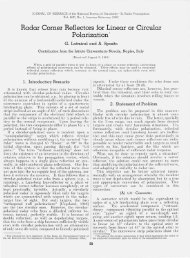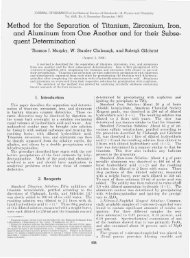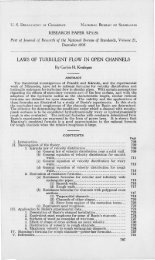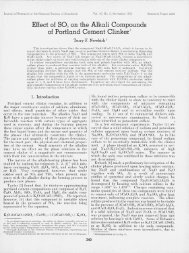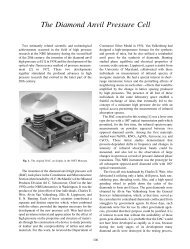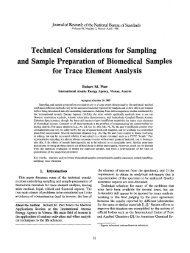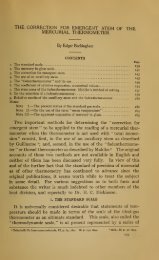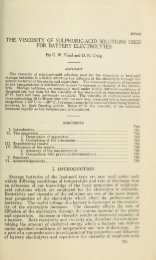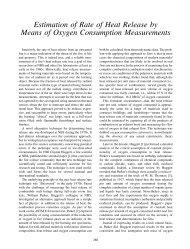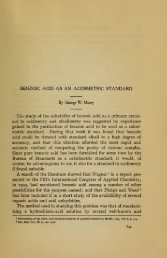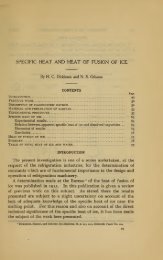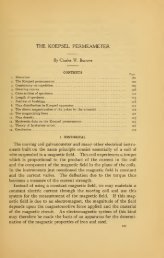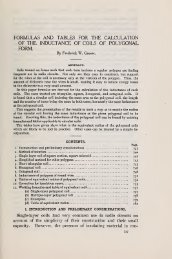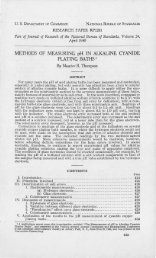Cyclic polyhydroxy ketones. II. xylo-trihydroxycyclohexenediolic acid ...
Cyclic polyhydroxy ketones. II. xylo-trihydroxycyclohexenediolic acid ...
Cyclic polyhydroxy ketones. II. xylo-trihydroxycyclohexenediolic acid ...
Create successful ePaper yourself
Turn your PDF publications into a flip-book with our unique Google optimized e-Paper software.
solution of this in a hot mixture of 180 ml of absolute<br />
ethanol and 20 ml of glacial acetic <strong>acid</strong> was<br />
treated with decolorizing carbon, filtered, and kept<br />
for 18 hI' in a refrigerator. The resulting crystals<br />
were separated and dried; wt, 1.5 g: rnp 165 to 166<br />
°0, in agreement with the value reported for pentaacetoAJ7benzene<br />
[14] . By recrystallization from<br />
hot, glacial acetic <strong>acid</strong>, the melting point was raised<br />
to 166 to 168 °0. The once-recrys tallized material<br />
was used for preparing pentahydroxybenzene (section<br />
5.3).<br />
(2) Aromatization of acetates. For each of the<br />
three pcntaacetates described in section 5.2e, a<br />
250-mg sample was dissolved in a mixture of 10 ml<br />
of pyridine and 5 ml of acetic anhydride. The<br />
solution was heated to boiling, kept at room temperature<br />
for 2 hI', and poured into ice water. The<br />
product (approximately 200 mg) was separated and<br />
recrystallized from ethanol, or from a mixture of<br />
ethanol and acetic <strong>acid</strong>. Each of the products<br />
melted at 169 to 171 °0 and showed an infrared<br />
spectrum identical with that of the product derived<br />
from I by simultaneous acetylation and aromatization.<br />
5.3. Pentahydroxybenzene<br />
A mixture of 1 g of pentaacetoxybenzene, 50 ml<br />
of methanol, and 5 ml of concentrated hydrochloric<br />
<strong>acid</strong> was placed in a 200-ml fl ask equipped with a<br />
reflux condenser. Under a stream of nitrogen,<br />
the mixture was gently boiled for 15 min ; the lightyellow<br />
solution was then filtered, and concentrated<br />
under r educed pressure (40 °0). The resul ting paleyellow<br />
crystals were separated by filtration, washed<br />
with 25 ml of cold ether, and dried in a vacuum<br />
desiccator ; wt, 325 mg. For recrystallization, 100<br />
mg was dissolved in 10 ml of boiling absolute ethanol ;<br />
the solution was concentrated to about 2 ml, and<br />
pentane (about 2 ml) was added to incipient turbidity.<br />
The slightly pinkish crystals that separated<br />
on cooling were collected by f-tltration,<br />
washed with pentane, and dried ; wt, 60 mg. The<br />
substance does not melt, but decomposes slowly at<br />
255 to 265 °0. The analysis of the product did not<br />
correspond exactly with that of anllydrous pentahydroxybenzene,<br />
but was sufficiently close to show<br />
that the material was, indeed, pentahydroAJ7benzene.<br />
Anal. Oalcd. for 06H605: 0,45.6; H , 3.8. Found:<br />
0, 44.4; H, 3.8.<br />
Freshly prepared meth anolic solutions of pentabydroAJ7benzene<br />
are usually slightly yellow; they<br />
turn deep red on exposure to ail'. Ferric chloride<br />
solution imparts a pink color tb at rapidly deepens to<br />
magenta. PentahydroAJ'b enzene is sensitive to oxidation;<br />
even <strong>acid</strong>-washed decolorizing carb on causes<br />
a solution of the compound to turn deep red.<br />
At room temperature, the substance reduces Benedict<br />
solution and also silver nitrate, the latter<br />
almost instantaneously.<br />
5.4. xy 10 -Trihydroxycyclohexa ne-l,2,3,-trione (<strong>II</strong>)<br />
a . Preparation and Properties<br />
A solution of I (1 g) in 10 ml of stirred, concentrated<br />
nitric <strong>acid</strong> was heated for 5 min on a<br />
722- 641- 64- - 4 293<br />
steam bath, at which point n began to crystallize.<br />
The reaction mixture was cooled in ice, diluted with<br />
25 ml of cold methanol, and kept 5 min. The resulting<br />
crystals were separated on a fritted-glass<br />
fi lter and washed with methanol; the filtrate was<br />
discarded. 1O The fairly pure product began to<br />
darken at 200 °0 and decomposed, without melting,<br />
at 220 to 225 °0. 11<br />
The compound may be r ecrystallized in low yield<br />
from hot water . rr (1.5 g) was dissolved in 125<br />
ml of hot water, and the solution was decolorized,<br />
filtered, and concentrated under r educed pressure<br />
to a sirup which was diluted with 50-percent rtqueous<br />
methanol and kept at room temperature for 3 days.<br />
The r esulting crystals wer e collected by filtration,<br />
washed with methanol, and dried; yield, 0.25 g.<br />
The infrared pectrum was unchanged by r ecrystallization.<br />
After being dried for 4 hI' at 25 °0/0.1<br />
mm, the compound was analyzed.<br />
Anal. Ortlcd. for 06H606+ 1·5H20 : 0, 35.8; H,<br />
4.5. Found: 0, 35.8: H , 4.6.<br />
After being dried 1 hI' at llO °0/0.1 mm, it was<br />
reanalyzed. Oalcd. for 06H 60d-I20: 0, 37.5; H,<br />
4.2. Found: 0, 38.0; H, 4.2.<br />
A warm solution of <strong>II</strong> reduced Benedict solution<br />
instantaneously . On being heated, an aqueous<br />
solution of <strong>II</strong> decomposes slowly, giving oxalic <strong>acid</strong><br />
as one of the deco l11_position products. An aqueous<br />
solution, treated at 60 °0, in air, with a solution of<br />
ammonium carbonate, changes color to deep yellow<br />
and finally deposits dark-blue needles of ammonium<br />
rhodizonate [17].<br />
b. Simultaneous Acetylation and Aromatization<br />
<strong>II</strong> (500 mg) was added to a hot, stirred mixture of<br />
25 ml of acetic anhydride and 5 g of rtnbydl'ous<br />
sodium acetate. Af tel' 5 min, the mixtw'e was<br />
cooled and poured into 100 ml of ice water. The<br />
solid that separated was collected by filtmtion,<br />
washed with water, and recrystallized from 15 1111<br />
of boiling acetic <strong>acid</strong> con tai ning decolorizing carbon.<br />
The suspension was flHered and thc filtrate cooled;<br />
the resulting crystals wer e separ ated, washed -with<br />
acetic <strong>acid</strong>, and dried over sodium hydroxide in a<br />
vacuum desiccator; wt, 0.3 g; mp 203 to 205 °0.<br />
The product was identical, in melting point and infrared<br />
spectrum, with an authentic sample of<br />
hexaacetoxybenzene [24].<br />
On hych'olysis with warm, 85-percent phosphoric<br />
<strong>acid</strong>, the acetate yielded needlelike crystals identical<br />
with those of hexahydroxybenzene [17].<br />
c. Bis(phenylhydrazone}<br />
<strong>II</strong> (300 mg) was dissolved in 75 ml of 7.5-percent<br />
aqueous acetic aeid by warming slightly. To the<br />
stirred solution were added 50 g of crushed ice and<br />
5 ml of phenylhydrazine. After 1 hI', the resulting<br />
10 l\1ixtures of nitric <strong>acid</strong> ancl lnethanol should not, of course , be concentrated<br />
with heating beca use of the dangor of violent decom position.<br />
<strong>II</strong> Oompound <strong>II</strong> cun also be obtained by oxidation of I with iodine, neutral<br />
potassiulI1 pCflll anganatc, or a cold solution of silver nitrate.
absorption at the observed Amax at 302 to 306 m,u<br />
decreases with time (fig. 6, 8). The identity of the<br />
spectra in water and aqueous acetic <strong>acid</strong> indicates<br />
that this band can be attributed to nonenolized<br />
carbonyl groups. The observed maximum is in<br />
approximate agreement with the maxima (295 to<br />
301 m,u) reported for two isolated carbonyl groups<br />
[37] . Aqueous solutions of <strong>II</strong> show a weak band at<br />
about 365 m,u, in addition to the band at 302 to<br />
306 m,u.<br />
If the aqueous solution of <strong>II</strong> is treated with sodium<br />
carbonate, the solution becomes deep yellow, presumably<br />
through successive enolization and betaelimination<br />
reactions, as represented for the acetates<br />
of <strong>II</strong> in figure 4. Bands appear in the ultraviolet<br />
and visible spectra near 296, 368, 422 (sh), and 482<br />
m,u. The band at 368 m,u can be assigned to the<br />
anion of an enolized keto group [38]. The bands at<br />
296, 422, and 482 m,u are similar to those observed<br />
for tetrahydroxy-p-benzoquinone in methanol at<br />
312, 441, and 482 m,uJ3 [39] and for p-benzoquinone<br />
at 296 and 435 m,u. The bands for p-benzoquinone<br />
have been ascribed to a conjugated keto group [40].<br />
Absorption by quinones in the region of 410 to 440<br />
m,u has been ascribed to an n -7r * transition [41 , 42,<br />
43].<br />
When the alkaline solution of <strong>II</strong> is <strong>acid</strong>ified with<br />
acetic <strong>acid</strong>, a broad band is produced with Amax at 269<br />
to 275 m,u; this band corresponds to a benzenoid<br />
structure ([25], pp. 116- 120) , in agreement with<br />
the expected aromatization and formation of hexahydroxybenzene.<br />
The solution, on treatment with<br />
methanolic ferric chloride, gave the magenta color<br />
typical of the reaction of phenols. Thus, the spectra<br />
and chemical properties indicate that <strong>II</strong>, in alkaline<br />
solu tion, undergoes aromatization and complex<br />
oxidation- reduction reactions.<br />
The infrared spectrum of <strong>II</strong> (fig. 7, 8) shows<br />
a single band at 5.70 ,u, that is, at a somewhat shorter<br />
wavelength than that to be expected for dicarbonyl<br />
compounds (5.78 to 5.85 ,u [36], p. 62, [32], pp. 483-<br />
484). A b and at 6.12 ,u can be attributed to water<br />
([32], p. 430, [34], [33], p. 150).<br />
The ultraviolet spectrum of pentaacetoxybenzene,<br />
either in glacial acetic <strong>acid</strong> or in methanol (fig. 6,<br />
9), shows a single band, Arn ax 267 to 268 m,u, within<br />
the region characteristic of benzenoid compounds<br />
([25], p. 116) .<br />
The infrared spectrum of pentaacetoxybenzene<br />
(fig. 7, 9) is consistent with the aromatic structure.<br />
Bands were observed at: 2.31 ,u (C- H aromatic<br />
str etching); 6.15 ,u (olefinic bond); 6.70 ,u (aromatic<br />
ring); and 11.18 and 11.48 ,u (C- H out-of-plane<br />
deformation of the isolated hydrogen atom on a<br />
pentasubstituted benzene ring) . The strong band<br />
at 11.95 ,u is probably also associated with an isolated<br />
hydrogen atom on the benzene ring ([35],<br />
pp. 69- 79, [32], p. 394, [31], pp. 26, 27).<br />
The methyl groups of the acetoxy substituents<br />
are associated with absorption at: 6. 85 ,u (C- H<br />
asymmetric deformation); 7.28 ,u (C- H symmetrical<br />
13 In addition, there is a strong band in the visible region, at 510 m/,.<br />
298<br />
deformation); 13.22 and 13.85 ,u (C- H skeletal<br />
vibration) [36], p. 57). Ester bands were obsened<br />
at 5 .60,u (phenolic acetate), and 8.00 ,u (sh) (acetate).<br />
A strong band at 8.50 ,u is probably associated with<br />
the acetoxy substituent ([36], p. 64).<br />
Freshly prepared pen tahydroxybenzen e, when<br />
dissolved in methanol, shows a band at Amax near<br />
292 m,u whose intensity increases with time (fig. 6, 10) .<br />
Pentahydroxybenzene is extremely sensitive to<br />
oxidation by air. A methanolic solu tion, exposed<br />
to air, quickly acquires a red color and shows absorption<br />
bands at 288, 358, and 490 m,u. In comparison,<br />
2,3,5-trimethoxy-p-benzoquinone absorbs at<br />
288 m,u in ethanol [44], and hydro quinone absorbs<br />
at 294 m,u ([25], p. 119).<br />
The infrared spectrum of pentahydroxybenzene<br />
(fig . 7, 10) is also consistent with an aromatic<br />
structure. It shows a band at 6.10 ,u (C= C)<br />
and at 6.55 ,u (substituted benzene ring [35], pp. 71,<br />
72). Characteristic strong bands observed at 12 .25<br />
and 13.70 ,u are indicative of C- H out-of-plane<br />
deformation and of the presence of one free hydrogen<br />
atom on the ring. However , a band was<br />
not observed in the region of 3.4 to 3.5 ,u, characteristic<br />
of C- H stretching. Bands found at<br />
9.62, 10.30, and 10.80 ,u are apparently associated<br />
with pentasubstitution on the ring ([35], p. 79;<br />
[36], p. 59; [32], p. 394).<br />
The authors express their appreciation to H. L.<br />
Frush and R. S. Tipson for highly valued counsel<br />
and assistance in preparing the manuscript.<br />
6. References<br />
[ I] J . Schcrcr , Ann. 73, 322 (1850), 81,375 (1852).<br />
[2] L . M aqucnne, Compt. Rend. 104, 297 (1887).<br />
[3] T . Posternak, H elv . Chim. Acta 19, 1333 (1936).<br />
[4] T. Post ernak , Helv. Chim. Acta 24, 1045 (1941).<br />
[5] P . W. Preisler and L. Berger , J. Am. Chem. Soc. 64, 67<br />
(1942) .<br />
[6] H. von Euler and B . Eistert, Chemie und Biochemie del'<br />
Reduktone a nd Reduktonate (Ferdinand Enke<br />
Verlag, Stuttgart, Germany, 1957).<br />
[7] W . Pigman, The Carbohydrates, p. 329 (Academic<br />
Press Inc., New York, N.Y., 1957).<br />
[8] B. Magasanik and E. Charga ff, J. BioI. Che m. 174,<br />
173 (1948).<br />
[9] S. J. Angyal and L. Anderson , Advan. Carbohydrate<br />
Chem . 14, 135 (1959) .<br />
[10] H . G. Fletcher, Jr., Advan. Carbohydrate Chem . 3, 45<br />
(1948.)<br />
[11 ] H. S. Isbell, Ann. R ev. Biochem . 12, 213 (1943).<br />
[12] H. S. Isbell, J . R es. NBS 32, 45 (1944) RP 1573.<br />
[13] W. Baker , J. Chem . Soc. 1941, 662.<br />
[14] A. Einhorn, J. Cobliner, and H. Pfeiffer, Ber. 37, 100<br />
(1904) .<br />
[15] R. Niet ski a nd T. Benckiser , Bel' . 18,1833 (1885).<br />
[16] A. J. Fatiadi and W. Sager, Org. Syn.



